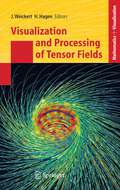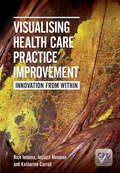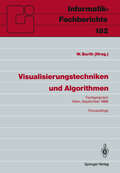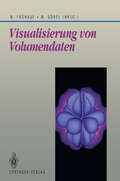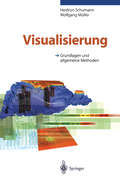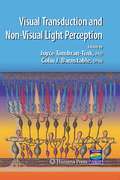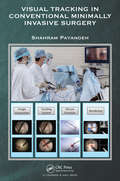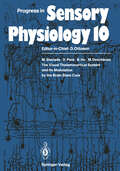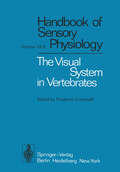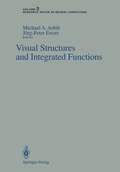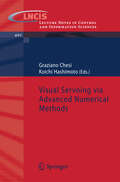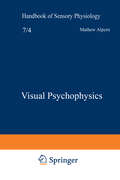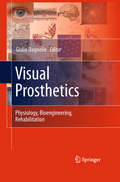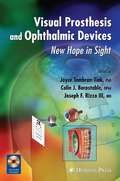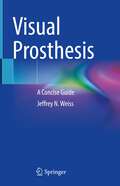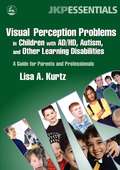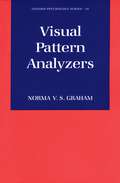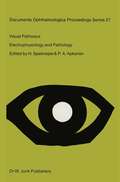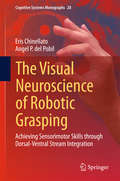- Table View
- List View
Visualization and Processing of Tensor Fields (Mathematics and Visualization)
by Joachim Weickert Hans HagenMatrix-valued data sets – so-called second order tensor fields – have gained significant importance in scientific visualization and image processing due to recent developments such as diffusion tensor imaging. This book is the first edited volume that presents the state of the art in the visualization and processing of tensor fields. It contains some longer chapters dedicated to surveys and tutorials of specific topics, as well as a great deal of original work by leading experts that has not been published before. It serves as an overview for the inquiring scientist, as a basic foundation for developers and practitioners, and as as a textbook for specialized classes and seminars for graduate and doctoral students.
Visualising Health Care Practice Improvement: Innovation from Within
by Rick Iedema Jessica Mesman Katherine CarrollWhy is it that in spite of all the health policy reforms, clinical practice innovations, increasing intersectoral interdependencies and new medical and information technologies, so little has changed in the way we research and evaluate health care? Don't these changes cry out for new ways of being studied and appraised? And don't our approaches to clinical practice innovation cry out for being reinvented too? Surely, we cannot continue to wheel out research and evaluation paradigms, improvement approaches and methods that were designed for 20th century problems and 20th century health care, and assume they will be able to make sense of the problems we experience and the care we provide in the 21st century? These changes necessitate a new paradigm of health service research, evaluation and improvement and this new model adopts approaches and methods that embrace complexity. The approaches and methods can account for the vicissitudes of front-line care, the activities of front-line staff and the experiences of patients and families - where care happens. Visualising Health Care Practice Improvement draws on years of video feedback research shaping an approach that enables not only a retrospective understanding but also a view into the future, of what might be possible. It presents the argument that change is not principally about adopting solutions from elsewhere but that it is conditional on people exploring whether proposed solutions suit existing habituations. It involves a process of exploration, discovery, secession and renewal. Health care managers, policy makers and shapers will find this book enlightening. It will also be empowering to all health care professionals and front-line staff.
Visualising Health Care Practice Improvement: Innovation from Within
by Rick Iedema Jessica Mesman Katherine CarrollWhy is it that in spite of all the health policy reforms, clinical practice innovations, increasing intersectoral interdependencies and new medical and information technologies, so little has changed in the way we research and evaluate health care? Don't these changes cry out for new ways of being studied and appraised? And don't our approaches to clinical practice innovation cry out for being reinvented too? Surely, we cannot continue to wheel out research and evaluation paradigms, improvement approaches and methods that were designed for 20th century problems and 20th century health care, and assume they will be able to make sense of the problems we experience and the care we provide in the 21st century? These changes necessitate a new paradigm of health service research, evaluation and improvement and this new model adopts approaches and methods that embrace complexity. The approaches and methods can account for the vicissitudes of front-line care, the activities of front-line staff and the experiences of patients and families - where care happens. Visualising Health Care Practice Improvement draws on years of video feedback research shaping an approach that enables not only a retrospective understanding but also a view into the future, of what might be possible. It presents the argument that change is not principally about adopting solutions from elsewhere but that it is conditional on people exploring whether proposed solutions suit existing habituations. It involves a process of exploration, discovery, secession and renewal. Health care managers, policy makers and shapers will find this book enlightening. It will also be empowering to all health care professionals and front-line staff.
Visualisierungstechniken und Algorithmen: Fachgespräch Wien, 26./27. September 1988, Proceedings (Informatik-Fachberichte #182)
by Wilhelm BarthDieser Band enthält die Beiträge eines Fachgesprächs, das am 26. und 27. September 1988 an der Technischen Universität Wien stattfand. Visualisierungstechniken sind ein zentrales Thema der Computer-Graphik mit zahlreichen Anwendungsgebieten. Neben den Fachbeiträgen bilden daher die Anwendungen einen wesentlichen Bestandteil des Fachgesprächs. Drei eingeladene Beiträge geben Übersichten über Visualisierungstechniken in der "Photogrammetrie und Fernerkundung", in der "Molecular Graphics", sowie bei komplexen, großen Datenmengen. In drei Minisymposien werden unterschiedliche Themen behandelt. Das erste gibt eine Darstellung verschiedener Anwendungen: "Visualisierung natürlicher Phänomene"; im zweiten werden Algorithmen untersucht: "Geometrische Verfahren der Graphischen Datenverarbeitung - Spezielle Visualisierungstechniken"; das dritte stellt das komplette Visualisierungssystem RISS vor, mit dem realistische Bilder durch Ray-Tracing erzeugt werden können. Die Themen der angenommenen Vorträge reichen von der Hardware für Computer-Graphik über spezielle Probleme und Verfahren der Raster-Graphik (Anti-Aliasing, Ray-Tracing) und Algorithmen bis zu weiteren Anwendungen (Medizin, Kartographie). Aber auch Fragen der Bildanalyse, Bildauswertung und Animation werden behandelt.
Visualisierung von Volumendaten (Beiträge zur Graphischen Datenverarbeitung)
by Martin Ühauf Martin GöbelIn vielen verschiedenen Disziplinen der Natur- und Ingenieurwissenschaften produzieren Meßverfahren, Experimente und Computersimulationen immer größer werdende Mengen von Ergebnisdaten. Diese Daten sind oft so komplex, daß spezielle Verfahren zur graphischen Darstellung eingesetzt werden müssen, um überhaupt eine Interpretation und eine Analyse der Ergebnisse zu ermöglichen. Viele dieser Quellen produzieren Daten, die über drei räumliche Koordinaten definiert sind. Solche Daten werden Volumendaten genannt. Beispiele für solche Datenquellen sind Finite-Element-Simulationen, bildgebende Verfahren in der Medizin und Materialprüfung sowie Elektronenverteilungen in Chemie und Physik. Zur Visualisierung dieser Volumendaten werden in den letzten Jahren besondere graphische Vefahren entwickelt. Das Buch enthält Beiträge nahezu aller führenden deutschen Wissenschaftler auf diesem Gebiet und gibt einen Überblick über die Forschungs- und Entwicklungsaktivitäten.
Visual Transduction And Non-Visual Light Perception (Ophthalmology Research)
by Joyce Tombran-Tink Colin J. BarnstableThis book reveals not only how the eye evolved into an organ of vision, but also describes how molecular mechanisms of key molecules operate in the phototransduction cascade. In this groundbreaking text, experts also explain mechanisms for sensing radiation outside of the visible wavelengths. Comprehensive and penetrating, the book brings together the mechanisms of the visual transduction cascade and is an invaluable text for everyone conducting research in the visual system.
Visual Tracking in Conventional Minimally Invasive Surgery
by Shahram PayandehVisual Tracking in Conventional Minimally Invasive Surgery introduces the various tools and methodologies that can be used to enhance a conventional surgical setup with some degree of automation. The main focus of this book is on methods for tracking surgical tools and how they can be used to assist the surgeon during the surgical operation. Various notions associated with surgeon–computer interfaces and image-guided navigation are explored, with a range of experimental results. The book starts with some basic motivations for minimally invasive surgery and states the various distinctions between robotic and non-robotic (conventional) versions of this procedure. Common components of this type of operation are presented with a review of the literature addressing the automation aspects of such a setup. Examples of tracking results are shown for both motion and gesture recognition of surgical tools, which can be used as part of the surgeon–computer interface. In the case of marker-less tracking, where no special visual markers can be added to the surgical tools, the tracking results are divided into two types of methodology, depending on the nature and the estimate of the visual noise. Details of the tracking methods are presented using standard Kalman filters and particle filters. The last part of the book provides approaches for tracking a region on the surgical scene defined by the surgeon. Examples of how these tracking approaches can be used as part of image-guided navigation are demonstrated. This book is designed for control engineers interested in visual tracking, computer vision researchers and system designers involved with surgical automation, as well as surgeons, biomedical engineers, and robotic researchers.
The Visual Thalamocortical System and Its Modulation by the Brain Stem Core (Progress in Sensory Physiology #10)
by Mircea Steriade D. Pare B. Hu M. DeschenesThis monographic work authored by eminent neurophysiologists will be of major interest to researchers investigating the visual system or working in behavioral neuroscience and sleep research. The book deals with the neuronal circuits of the visual thalamocortical system, the brainstem and basal forebrain modulatory systems and their neurotransmitters acting upon these circuits, and the neuronal activities in the visual thalamocortical system as changed during shifts in behavioral states of vigilance from wake to sleep. Data discussed consist of recent studies on light and electron microscopy, extra- and intracellular recordings of thalamic and cortical neurons, neurotransmitter actions, and state-dependent cellular activities in the visual system.
The Visual System in Vertebrates (Handbook of Sensory Physiology #7 / 5)
by F. CrescitelliThe vertebrate eye has been, and continues to be, an object of interest and of inquiry for biologists, physicists, chemists, psychologists, and others. Quite apart from its important role in the development of ophthalmology and related medical disciplines, the vertebrate eye is an exemplar of the ingenuity of living systems in adapting to the diverse and changing environments in which vertebrates have evolved. The wonder is not so much that the visual system, like other body systems, has been able to adapt in this way, but rather that these adaptations have taken such a variety of forms. In a previous volume in this series (VII/I) Eakin expressed admiration for the diversity of invertebrate photoreceptors. A comparable situation exists for the vertebrate eye as a whole and one object of this volume is to present to the reader the nature of this diversity. One result of this diversification of ocular structures and properties is that the experimental biologist has available a number of systems for study that are unique or especially favorable for the investigation of particular questions in visual science or neurobiology. This volume includes some examples of progress made by the use of such specially selected vertebrate systems. It is our hope that this comparative approach will continue to reveal new and useful preparations for the examination of important questions.
The Visual System: Neurophysiology, Biophysics, and Their Clinical Applications (Advances in Experimental Medicine and Biology #24)
by G. ArdenThe International Society for Clinical Electroretinography provides a link between scientists who are enlarging our understanding of the normal functioning of the visual pathway, and clinicians who investigate and treat visual disturbances. The chief function of the Society is to organise symposia, where, with skill born of long practice, the participants obtain the benefits of both social and scientific contact, without detriment to either. The result ing spread of information is documented both in the society's Newsletter, and by the publication of volumes such as this, the record of the 9th Symposium held at Brighton in 1971. This meeting was a joint Symposium of the ISCERG and the International Union of Physiological Sciences. The subjects covered represent merely the interests of the organisers. The biophysical studies are represented by chapters on such divers topics as the x-ray diffraction of receptor membranes and impedance properties of outer limb suspensions. Other papers deal with the problems of maintaining the retina in vitro in a physiological condition. Papers describing techniques for investigating the functional properties of the visual system shade into those which describe new aspects of human disease. In the past such serendipity has been of value as evidenced by compal-ison between this and previous volumes. In 1965 the physiological section of the Proceedings was largely devoted to a new elec trical response, the evoked potential of the visual cortex.
Visual Structures and Integrated Functions (Research Notes in Neural Computing #3)
by Michael A. Arbib Jörg-Peter EwertThis volume integrates theory and experiment to place the study of vision within the context of the action systems which use visual information. This theme is developed by stressing: (a) The importance of situating anyone part of the brain in the context of its interactions with other parts of the brain in subserving animal behavior. The title of this volume emphasizes that visual function is to be be viewed in the context of the integrated functions of the organism. (b) Both the intrinsic interest of frog and toad as animals in which to study the neural mechanisms of visuomotor coordination, and the importance of comparative studies with other organisms so that we may learn from an analysis of both similarities and differences. The present volume thus supplements our studies of frog and toad with papers on salamander, bird and reptile, turtle, rat, gerbil, rabbit, and monkey. (c) Perhaps most distinctively, the interaction between theory and experiment.
Visual Servoing via Advanced Numerical Methods (Lecture Notes in Control and Information Sciences #401)
by Graziano Chesi Koichi HashimotoRobots able to imitate human beings have been at the core of stories of science?ctionaswellasdreamsofinventorsforalongtime.Amongthe various skills that Mother Nature has provided us with and that often go forgotten, the ability of sight is certainly one of the most important. Perhaps inspired by tales of Isaac Asimov, comics and cartoons, and surely helped by the progress of electronics in recent decades, researchers have progressively made the dream of creating robots able to move and operate by exploiting arti?cial vision a concrete reality. Technically speaking, we would say that these robots position themselves and their end-e?ectors by using the view provided by some arti?cial eyes as feedback information. Indeed, the arti?cial eyes are visual sensors such as cameras that have the function to acquire an image of the environment. Such an image describes if and how the robot is moving toward the goal and hence constitutes feedback information. This procedure is known in robotics with the term visual servoing, and it is nothing else than an imitation of the intrinsic mechanism that allows human beings to realize daily tasks such as reaching the door of the house or grasping a cup of co?ee.
Visual Psychophysics (Handbook of Sensory Physiology #7 / 4)
by Dorothea Jameson L. M. HurvichThis volume on Visual Psychophysics documents the current status of research aimed toward understanding the intricacies of the visual mechanism and its laws of operation in intact human perceivers. As can be seen from the list of contributors, the problems of vision engage the interest and experimental ingenuity of investi gators from a variety of disciplines. Thus we find authors affiliated with depart ments of biology, medical and physiological physics, ophthalmology, physics, physiology and anatomy, psychology, laboratories of neurophysiology, medical clinics, schools of optometry, visual and othcr types of research institutes. A continuing interplay between psychophysical studies and physiological work is everywhere evident. As more information about the physiological basis of vision accumulates, and new studies and analyses of receptor photochemistry and the neurophysiology of retina and brain appear, psychophysical studies of the intact organism become more sharply focused, sometimes more complex, and often more specialized. Technological advances have increased the variety and precision of the stimulus controls, and advances in measurement techniques have reopened old problems and stimulated the investigation of new ones. In some cases, new concepts are being drawn in to help further our under standing of the laws by which the visual mechanism operates; in other cases, ideas enunciated long ago have been reevaluated, developed more fully, and reified in terms of converging evidence from both psychophysical experiments and unit recordings from visual cells.
Visual Prosthetics: Physiology, Bioengineering, Rehabilitation
by Gislin DagnelieVisual Prosthetics provides an in-depth analysis of the principles of operation, current state, anticipated developments, and functional aspects of visual prosthetics restoring sight to visually impaired individuals. This volume uniquely describes the human visual system in health and disease in a pedagogical and didactic manner, fitting to professionals and researchers with a bioengineering background. Readers will find a balanced overview of electrical, molecular chemical and synthetic chromophore stimulation, in addition to the biophysics and psychological aspects of vision restoration. Unlike competitive texts, this introduction also includes the need and methods for functional evaluation and rehabilitation.Professionals in the field of biomedical engineering and graduate and postgraduate researchers will find Visual Prosthetics a valuable reference.
Visual Prosthesis and Ophthalmic Devices: New Hope in Sight (Ophthalmology Research)
by Joyce Tombran-Tink Colin J. Barnstable Joseph F. RizzoThis volume details the latest technology in treating eye injuries and infections. It provides insight into the most up-to-date and established treatment options. The volume focuses on what can currently be achieved with a variety of ocular prostheses as well as what the future holds. Coverage reviews issues such as intraocular lens implants, biocompatibility of materials, retinal implants, testing models, and software designs.
Visual Prosthesis: A Concise Guide
by Jeffrey N. WeissFor the millions of people with untreatable blindness the thought of a visual prosthesis that would allow them to live a normal life has always been a distant hope. There have been intermittent bright spots that periodically fan that hope such as when Dr. Dobelle’s visual prosthesis patient drove a car in an empty parking lot. This book will serve as an update of the work in developing a visual prosthesis. Chapters discuss the physiologic and engineering issues, alternative strategies, and patents, as well as recent research studies. Visual Prosthesis - A Concise Guide is a must-have resource for ophthalmologists, neurologists, engineers and physicists.
Visual Perception Problems in Children with AD/HD, Autism, and Other Learning Disabilities: A Guide for Parents and Professionals
by Lisa A. KurtzThis book provides a comprehensive overview of vision problems in children with developmental disabilities such as AD/HD, autism spectrum disorders, and specific learning disabilities. Written in a very accessible style, it is appropriate for parents and professionals alike and offers non-technical explanations of how vision difficulties are screened for and advice on where to seek appropriate professional care. Lisa Kurtz outlines a range of activities for strengthening children's functional vision and perceptual skills using simple, homemade materials that are readily available in the home or classroom. This is an excellent practical companion for parents of children with visual perception problems and the professionals who work with them.
Visual Perception Problems in Children with AD/HD, Autism, and Other Learning Disabilities: A Guide for Parents and Professionals (PDF)
by Lisa A. KurtzThis book provides a comprehensive overview of vision problems in children with developmental disabilities such as AD/HD, autism spectrum disorders, and specific learning disabilities. Written in a very accessible style, it is appropriate for parents and professionals alike and offers non-technical explanations of how vision difficulties are screened for and advice on where to seek appropriate professional care. Lisa Kurtz outlines a range of activities for strengthening children's functional vision and perceptual skills using simple, homemade materials that are readily available in the home or classroom. This is an excellent practical companion for parents of children with visual perception problems and the professionals who work with them.
Visual Pattern Analyzers (Oxford Psychology Series)
by Norma Van GrahamThe visual system must extract from the light that falls on the retina meaningful information about what is where in our environment. At an early stage it analyzes the incoming sensory data along many dimensions of pattern vision, e.g. spatial frequency, orientation, velocity, eye-of-origin. Visual Pattern Analyzers provides a definitive account of current knowledge about this stage of visual processing. Nowhere else can such a comprehensive summarty of the lower level pattern analyzers be found. The book's emphasis is on psychophysical experiments measuring the detection and identification of near-threshold patterns -- and the mathematical models, such as multidimensional signal-detection theory, used to draw inferences from such experimental results -- but neurophysiological evidence is presented and compared critically to the psychophysical evidence. Introductory material on psychophysical methods, signal detection theory, and the mathematics of Fourier analysis is given in order to make the book more accessible to all who are interested in the lower or higher levels of visual perception. This volume will be of great value to researchers and graduate students in the fields of vision and perception. Within the scientific community there is wide interest in the visual system, and the book will be of use to investigators in many fields, including psychophysics, neuroscience, ophthalmology and optics, computer science, and cognitive and experimental psychology.
Visual Pathways: Electrophysiology and Pathology (Documenta Ophthalmologica Proceedings Series #27)
by H. Spekreijse P.A. ApkarianProceedings of the 18th ISCEV Symposium, held in Amsterdam, Netherlands, May 18-22 1980
Visual pathway (UEB uncontracted)
by Rnib BookshareThis image shows the pathway of the optic nerves from the eyes to the brain. There is a locator dot shown, which will be at the top left of the page when the image is the right way up. It is shown as a top-down (plan) view of a horizontal cross section through the eyes and brain (eyes on the left hand side, and back of head on the right hand side). It reads from left to right. The diagram is split into 5 vertical sections labelled above, and each section is separated by vertical dotted lines. The first section on the left is labelled Eyes, and below this are two circles representing eyes, with the left eye below the right eye. The sections after this are all within the brain. The second section Optic nerve shows a solid line extending from the left of each eye and a dashed line extending from the right of each eye. These are the optic nerves and labels next to the lines explain which side of the eye each optic nerve extends from. The next section Optic chiasm shows two of the optic nerves crossing. The left optic nerve from the right eye crosses the right optic nerve from the left eye. The next section Lateral geniculate bodies shows two circles. The lower one is on the left side of the brain, and the upper one is on the right side of the brain. The two solid lines from each eye meet at the lower circle and the two dashed lines meet at the upper circle. The final section Visual cortex shows the back of the brain, with the two hemispheres left and right. The dashed line from the right Lateral geniculate body goes to the right hemisphere and the solid line from the left Lateral geniculate body goes to the left hemisphere. This means that the right side of each eye is represented in the right hand side of the brain and the left side of each eye is represented in the left side of the brain.
Visual pathway (UEB contracted)
by Rnib BookshareThis image shows the pathway of the optic nerves from the eyes to the brain. There is a locator dot shown, which will be at the top left of the page when the image is the right way up. It is shown as a top-down (plan) view of a horizontal cross section through the eyes and brain (eyes on the left hand side, and back of head on the right hand side). It reads from left to right. The diagram is split into 5 vertical sections labelled above, and each section is separated by vertical dotted lines. The first section on the left is labelled Eyes, and below this are two circles representing eyes, with the left eye below the right eye. The sections after this are all within the brain. The second section Optic nerve shows a solid line extending from the left of each eye and a dashed line extending from the right of each eye. These are the optic nerves and labels next to the lines explain which side of the eye each optic nerve extends from. The next section Optic chiasm shows two of the optic nerves crossing. The left optic nerve from the right eye crosses the right optic nerve from the left eye. The next section Lateral geniculate bodies shows two circles. The lower one is on the left side of the brain, and the upper one is on the right side of the brain. The two solid lines from each eye meet at the lower circle and the two dashed lines meet at the upper circle. The final section Visual cortex shows the back of the brain, with the two hemispheres left and right. The dashed line from the right Lateral geniculate body goes to the right hemisphere and the solid line from the left Lateral geniculate body goes to the left hemisphere. This means that the right side of each eye is represented in the right hand side of the brain and the left side of each eye is represented in the left side of the brain.
Visual pathway (large print)
by Rnib BookshareThis image shows the pathway of the optic nerves from the eyes to the brain. There is a locator dot shown, which will be at the top left of the page when the image is the right way up. It is shown as a top-down (plan) view of a horizontal cross section through the eyes and brain (eyes on the left hand side, and back of head on the right hand side). It reads from left to right. The diagram is split into 5 vertical sections labelled above, and each section is separated by vertical dotted lines. The first section on the left is labelled Eyes, and below this are two circles representing eyes, with the left eye below the right eye. The sections after this are all within the brain. The second section Optic nerve shows a solid line extending from the left of each eye and a dashed line extending from the right of each eye. These are the optic nerves and labels next to the lines explain which side of the eye each optic nerve extends from. The next section Optic chiasm shows two of the optic nerves crossing. The left optic nerve from the right eye crosses the right optic nerve from the left eye. The next section Lateral geniculate bodies shows two circles. The lower one is on the left side of the brain, and the upper one is on the right side of the brain. The two solid lines from each eye meet at the lower circle and the two dashed lines meet at the upper circle. The final section Visual cortex shows the back of the brain, with the two hemispheres left and right. The dashed line from the right Lateral geniculate body goes to the right hemisphere and the solid line from the left Lateral geniculate body goes to the left hemisphere. This means that the right side of each eye is represented in the right hand side of the brain and the left side of each eye is represented in the left side of the brain.
The Visual Neuroscience of Robotic Grasping: Achieving Sensorimotor Skills through Dorsal-Ventral Stream Integration (Cognitive Systems Monographs #28)
by Eris Chinellato Angel P. del PobilThis book presents interdisciplinary research that pursues the mutual enrichment of neuroscience and robotics. Building on experimental work, and on the wealth of literature regarding the two cortical pathways of visual processing - the dorsal and ventral streams - we define and implement, computationally and on a real robot, a functional model of the brain areas involved in vision-based grasping actions.Grasping in robotics is largely an unsolved problem, and we show how the bio-inspired approach is successful in dealing with some fundamental issues of the task. Our robotic system can safely perform grasping actions on different unmodeled objects, denoting especially reliable visual and visuomotor skills.The computational model and the robotic experiments help in validating theories on the mechanisms employed by the brain areas more directly involved in grasping actions. This book offers new insights and research hypotheses regarding such mechanisms, especially for what concerns the interaction between the dorsal and ventral streams. Moreover, it helps in establishing a common research framework for neuroscientists and roboticists regarding research on brain functions.
